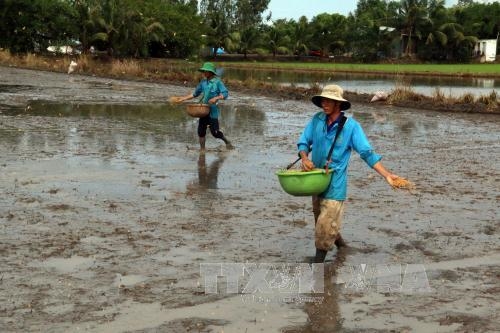 Economy
Economy

Many farmers in the Cửu Long (Mekong) Delta continue the traditional habit of sowing rice at a high density, leading to increased production costs and frequent disease outbreaks.
 |
| Farmers in the Mekong Delta have been encouraged to sow fields with fewer seeds to reduce production costs and prevent disease. — VNA/VNS Photo Lê Huy Hải |
HCM CITY — Many farmers in the Cửu Long (Mekong) Delta continue the traditional habit of sowing rice at a high density, leading to increased production costs and frequent disease outbreaks.
Despite local authorities’ recommendation to use 120 kilos of seed per ha, most farmers in Kiên Giang Province’s Tân Hiệp District, for example, use 150-180 kilos of seed.
Nguyễn Minh Tân, who uses the suggested 120 kilos, said his yield was the same as 150-180 kilos of seed sown per ha.
“However, only a few people are willing to do this because it requires more labour, and the surface of the fields must be levelled,” he said.
Tân learned about the new sowing method by attending a training course, which urges farmers to use less fertiliser and pesticide as well. The course was organised by Tân Hiệp District’s Agriculture and Rural Development Bureau.
Known informally as the “three reductions, three gains” model, the sowing method results in higher yields, quality and profits.
Tân said that initially his family did not want to use the model, so he divided his 3ha field, planting 180 kilos of seed on 1.5ha and 120 kilos on the remaining 1.5ha.
After harvesting, the yields from the two sections were equal, and production costs for the field sown with 120 kilo of seed were lower.
Nguyễn Trung Tiền, director of Kiên Giang Province’s Breeding Centre for Agriculture, Forestry and Fishery, said the higher-density sowing caused losses of about 20-30 per cent of plants.
Moreover, many farmers do not use high-quality seeds, so the germination rate is low.
“If farmers inevest in leveling the surface of their rice fields, they can cut production costs and reduce the seed quantity,” he said.
Farmers taking part in the province’s rice-seedling development programme are using the recommended 120 kilos of seed, according to Tiền.
The centre targets reducing the quantity of seeds to 80 kilo per ha in the future.
Nguyễn Văn Bá, who grows 1.5 ha of glutinous rice in An Giang Province, said his family used 130-140 kilos of seed per ha, helping cut costs for seed by VNĐ700,000-800,000 (US$32 - 36) per ha.
He also uses less fertiliser and needs less time to spray pesticide, increasing profits by VNĐ1.2 – 1.5 million ($55-68) per ha, compared to traditional methods.
Nguyễn Hữu An, head of An Giang Province’s Plant Protection Sub-department, said the province had instructed farmers in advanced farming techniques, including the use of high-quality seeds and new cultivation models.
New models
Besides the “three reductions, three gains” model, the province also promotes the "one must, five reductions" model in which certified seeds "must" be used.
The “reductions” refer to the number of seeds and as well as reduced amounts of crop-protection chemicals, nitrogenous fertiliser, water and post-harvest loss.
In Đồng Tháp Province, local authorities have instructed farmers to use fewer seeds, but many farmers continue to sow 120-180 kilos, and 200-220 kilos of glutinous rice seed per ha.
Farmer Trần Văn Liệt, who has grown rice in Đồng Tháp’s Hồng Ngự District for 30 years, said farmers would change their habits if they were shown evidence of the new model’s results on fields in their areas.
In February, the Ministry of Agriculture and Rural Development launched a programme in the Mekong Delta to reduce the quantity of sown seed, aiming to reduce the quantity to 80 kilos per ha by 2020.
If the target is achieved, the delta would save about 300,000 tonnes of seed or VNĐ 4.5 trillion ($204 million) a year, according to the ministry.
The delta’s rice farmers use an average of 150 kilos of seed per ha, while the rate is only 40 kilos per ha in the north.
The delta, which plants more than 4 million ha of rice every year, accounts for about 55 per cent of total rice cultivation in the country. —VNS




